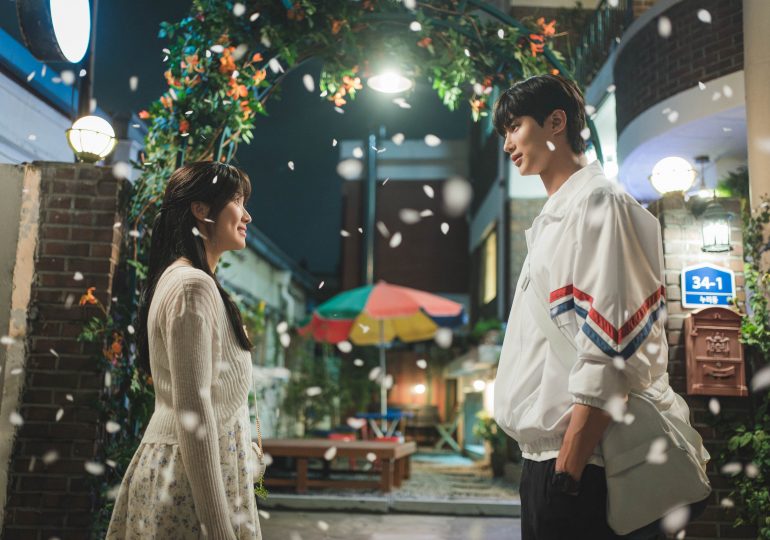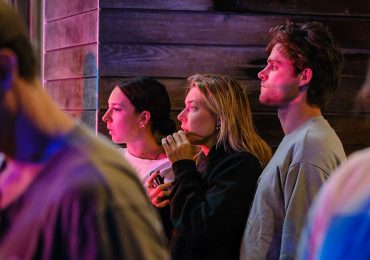Warning: This article contains spoilers for all of Lovely Runner.
We’re only halfway through 2024, but any upcoming Korean drama that is looking to steal the title of year’s best from Lovely Runner (선재 업고 튀어) is going to have to pull out all the stops. This week, the time-travel romance wrapped up its 16-episode tale on Viki, sticking its landing by prioritizing heart over plot mechanics. In a year that has seen some less-than-stellar K-drama conclusions, Lovely Runner defied the odds. It’s not that other K-dramas—from Queen of Tears to Sweet Home’s continuing story to Marry My Husband—haven’t been enjoyable; it’s that Lovely Runner has mixed nostalgia, romance, a murder subplot, and the emotional agonies of slipping back and forth through time to become something greater than the sum of its tropes. So let’s discuss how the series used familiar genres to craft a thrillingly unexpected, continuously moving story experience, becoming one of the spring’s most compelling streaming watches in the process.
[time-brightcove not-tgx=”true”]
What is Lovely Runner about?
At first glance, Lovely Runner seems like a relatively straightforward fan-idol romance, albeit with a time-travel twist. In the first episode, we meet Im Sol (Extraordinary You’s Kim Hye-yoon), a 34-year-old fan of K-pop star Ryu Sun-jae (20th Century Girl’s Byeon Woo-seok). The bulk of Lovely Runner’s first episode is set in 2023, and follows Sol in her normal life. A wheelchair user who aspires to make her own films, she has a steady job and a supportive family and is mostly happy. However, when superstar Sun-jae unexpectedly dies, seemingly by suicide, Sol is devastated. Sun-jae gave Sol personal advice at a time when she didn’t want to go on, and she has found immense comfort in their parasocial relationship ever since. That very night, Sol had even had the chance to meet Sun-jae, when he stopped his car on a snowy bridge to make sure she was OK after her wheelchair ran out of power.
In her despair and confusion, Sol falls into Seoul’s Cheonggyecheon Stream while wearing Sun-jae’s old watch, previously purchased in a fan auction. When she presses one of its buttons, the digital watch sends her back in time 15 years to the life she was living as a 19-year-old high school student in 2008. She vows to save Sun-jae from his future untimely death—whatever it takes.
The first time-slip
This goal may seem unrealistic, but Sol has a head start given that as a teenager, she happened to be neighbors with teenage swim star Sun-jae, a detail she somehow never put together. By the end of Episode 2, it’s further revealed that, while Teen Im Sol may have been ignorant of Teen Ryu Sun-jae’s existence, Teen Sun-jae has had a crush on Teen Sol. He’s been betsotted since he first saw Sol, yellow umbrella in hand, running through the rain. One of his most popular K-pop songs, “Sudden Shower,” was even inspired by the event.
This reveal recontextualizes their entire relationship, past and present: This isn’t just the story of a fan who travels back in time to save her bias; it’s the story of two people tied together by fate. “We live our lives as we miss out on many things,” muses Sol in Episode 5. “To me, Sun-jae was like a star in the sky, unreachable and a universe away … Only when I faced my past again, did I realize how many moments of connection I had missed.”
Unfortunately, Sol and Sun-jae’s unfurling destiny is not all sunshine and rainbows. Unbeknownst to the Sol who first slipped back in time, Sun-jae was the person who saved her from drowning in the accident that left her paralyzed—an incident caused by Kim Young-soo (Heo Hyung-kyu), a taxi driver with a penchant for serial kidnapping and murder. Kim Young-soo is tangled up in Sol and Sun-jae’s web of fate, bringing recurring tragedy into their love story.
After spending months as her teenage self, getting to know Sun-jae, and discovering he has always had feelings for her, Sol travels back to 2023 in Episode 7, leaving Sun-jae behind with her ignorant past self. Upon Sol’s initial return to 2023, she finds things somewhat changed. She has the use of her legs, having used her knowledge as a time traveler to escape Kim Young-soo’s clutches, and is working for a production company. When she reconnects with Sun-jae, who is still a star in this revised timeline, they finally confess their mutual feelings for one another. It seems like a happy ending, until Kim Young-soo pops back up again, stabbing Sun-jae and leaving him critically injured in the hospital. Desperate to save the love of her life, Sol activates Sun-jae’s watch—this time, with specific intention— and travels back to 2009, 10 days after she previously left.
The second time-slip
In this era, Sun-jae and Sol are enrolled at the same college. Though Sol initially tries to stay away from Sun-jae, convinced that it is their relationship that puts him in mortal danger, they eventually get together. “Stop running away from me. Just pursue your feelings for me,” Sun-jae tells Sol, when he figures out the truth of her time travel. “If I end up dying to save you, I’ll be fine with that. That doesn’t matter.” However, their happy ending is once again thwarted by Kim Young-soo, who comes after Sol. While trying to keep Sol safe, Sun-jae is stabbed and falls off a cliff into the ocean below, dying.
The third time-slip
Sol uses the watch for a third and final time to travel back to the first day Sun-jae noticed her: yellow umbrella in hand, running through the rain. Sol avoids Sun-jae altogether, erasing her existence from his life completely.
When Sol travels back to 2023, she is a hardworking film producer; she is happy, but when she gets drunk, she still cries about having to let Sun-jae go. But fate once again brings Sol and Sun-jae together. While Sun-jae has no memory of the time they shared together in the other versions of their lives, he is still drawn to Sol. When he reads a script she has written, a fictionalized version of their love story, he is moved to tears, and wants to star in the film.
Sol does everything she can to keep it from happening, but fate keeps bringing them together in echoes of the lost past. When the two get stuck in a ferris wheel car, a metaphor for the seemingly inescapable cycle they’re stuck in, Sun-jae wonders if they can’t change the ending of Sol’s script: “By the way, is that how it really ends? Is the man stuck in life without any memories of the woman he loved?”
Do Sol and Sun-jae have a happy ending?
Sol and Sun-jae get a happy ending, avoiding their tragic fate once and for all through the power of love and the impressive driving skills of Sol’s high school friend, Kim Tae-sung (Song Geon-hee). Tae-sung, who was characterized as a bit of a scoundrel in the initial timeline, has become a detective like his father in the revised version of the timeline—presumably, at least partially, because of Im Sol’s positive influence and support. When Kim Young-soo gets out of jail and starts stalking teenage girls again, Tae-sung is able to track him down.
A high-speed chase across a snowy Seoul seems poised to end in tragedy for Sun-jaen. Sun-jae has begun to remember his other lives with Sol, and stumbles out onto the street in front of Kim Young-soo’s car in his distress and confusion. It seems that Sol’s worst fear (that her presence always brings death into Sun-jae’s life) is about to be realized once again. However, Tae-sung manages to careen into Young-soo’s car first, stopping him from hitting Sun-jae.
Tae-sung pursues Young-soo on foot across Seoul, chasing him into a busy highway where the story’s villain is struck by a car and falls into the water below. It is an echo of Im Sol’s original fate at the hands of Young-soo. This time, however, Young-soo dies, leaving Sol and Sun-jae to their happy ending.
How did Sol’s grandmother end up with the watch?
Some sticklers for traditional time-travel plot mechanics may find Sol and Sun-jae’s ending unsatisfying. Sun-jae recovers his memories of Sol, despite never having lived them in this timeline. The recovery is somewhat explained through the musings of Sol’s grandmother, Jung Mal-ja (Seong Byeong-sook), who is living with dementia in 2023. Because of her condition, she herself often does not remember who Sol is, but she has moments of clarity about Sol’s time travel and her romance with Sun-jae that suggest she understands things that other characters do not. “Memories don’t disappear,” she tells Sol in one of these moments. “Where do you think all the countless memories of what you see, listen, and feel in your life go? They’re all seared onto my soul. Even if my brain forgot them, my soul hasn’t. It’s been keeping every piece of it.”
In the final episode, Mal-ja is also revealed to have the watch that allowed Sol to travel through time. She throws it into Cheonggyecheon Stream, ending the cycle of time travel and ensuring that Sol will stay in this timeline, with Sun-jae. When Sun-jae proposes to Sol and they embrace under the falling cherry blossoms, they both see a flash of their future wedding, suggesting it is a memory that they have not yet experienced. Still, like their multiple pasts, it is very much real.
While the impetus of the time travel is never fully revealed, it should be noted that, the first time we see Sun-jae’s watch—before Sun-jae’s initial death and before Sol first travels back in time—she is looking for Sun-jae’s watch so she can wear it to his concert. It is revealed to be on the wrist of Mal-ja, who has stolen it from Sol’s things while she was sleeping. Did Mal-ja do something to initiate the time-slips and, if so, how did she even know that they would be necessary? (This was before Sun-jae’s first untimely death.) We may never know, unless writer Lee Si Eun chooses to reveal further insight. Personally, I like to imagine that Mal-ja had her own experiences as a time traveler in her youth, but that is solely head canon.
Why the Lovely Runner ending (mostly) works
In its ending, Lovely Runner prioritizes emotional logic over plot logic—a trademark of Korean romantic melodrama that has been integral to the success of Hallyu, or the Korean Wave. Time-travel plots are notoriously hard to pull off because time travel doesn’t, you know, actually exist. Enforcing the burden of “realism” upon time-travel stories is a fool’s errand. However, like all stories, time-travel tales must have an internal logic and consistency to work. For Lovely Runner, that logic came in the central theme of a seemingly unavoidable fate and the many kinds of love (self, familial, platonic, and romantic) that led to a defiance of it. Using this logic, Lovely Runner was able to give viewers an incredibly satisfying story of love that transcends not only time, but fate. In the process, it was able to use a genre’s structure to give us three mini-stories in one—a high school romance, a college romance, and a workplace romance—tied together by incredible central performances from Kim and Byeon.
It is also noteworthy that Sol’s happy ending came not only in her relationship with Sun-jae, but in the opportunity to pursue her dream of becoming a film director. With the support of boyfriend Sun-jae, Sol writes and directs her first short film, which is seemingly a version of her love story with Sun-jae. For Sun-jae, who is initially portrayed as an unhappy idol, the realization of his career stays somewhat consistent throughout the timelines. While he enjoys being on stage, it is rather his love for Sol that truly brings about his happy ending, as he is finally given the chance to fully love and support her. This is consistent with the romantic K-drama format’s prioritization of the female gaze: In Lovely Runner, Sol is truly about to “have it all,” both professionally and in her domestic life. Meanwhile, Sun-jae is able to find fulfillment not through professional or interpersonal dominance, as the male gaze often dictates, but rather by supporting the woman he loves.
One notable way in which Lovely Runner fumbles its ending, however, comes in its ultimate depiction of disability as an obstacle to be “overcome” or “cured” in pursuit of the ultimate happy ending. In its first episode, Lovely Runner does a good job not depicting Sol’s disability as a tragedy, but rather as just one aspect of her character. As a wheelchair user, she is impacted by ableist systems, but that is framed as society’s inadequacy, not her own. This positive representation is undermined, however, by how quickly the show drops this aspect of her character as soon as she travels back in time. It would have been groundbreaking to see Sol’s happy ending include disability.
Lovely Runner’s (mostly) satisfying ending is further tied to its success as a series. Within fan culture, Lovely Runner has been seen as The Little K-Drama That Could: The production was reportedly stuck in development hell for three years before being greenlit. Despite having Lee Si Eun (True Beauty) on board as a writer and being based on a pre-existing web novel/webtoon called Tomorrow’s Best, casting was difficult. For 32-year-old Byeon, who was eventually cast as Ryu Sun-jae, it was his first role as a K-drama lead. Furthermore, the show streamed internationally on niche platform Viki rather than global powerhouse Netflix. The success of a show that was never supposed to be a big hit, and the attention it has brought both Byeon and Kim, feels like a kind of destiny. Happy endings are not guaranteed in the real world, but, if watching 선재 업고 튀어 has reminded us of anything this spring, isn’t it lovely to sometimes imagine we have the power to will them into existence?
Leave a comment








